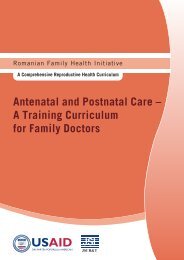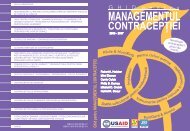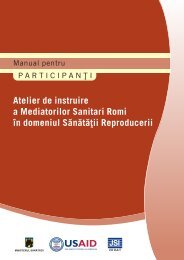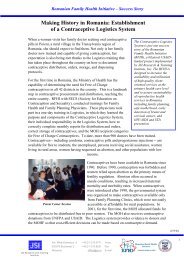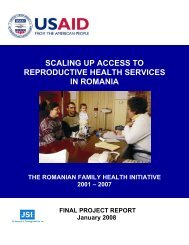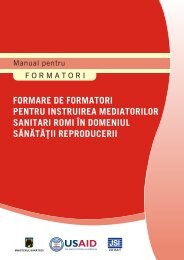Training of Roma Health Mediators in Reproductive Health
Training of Roma Health Mediators in Reproductive Health
Training of Roma Health Mediators in Reproductive Health
Create successful ePaper yourself
Turn your PDF publications into a flip-book with our unique Google optimized e-Paper software.
Tra<strong>in</strong>er document<br />
HIV/AIDS: WHAT IS TRUE? WHAT IS FALSE?<br />
Sample Discussion Po<strong>in</strong>ts<br />
HIV is the virus that causes AIDS. (TRUE)<br />
HIV (human immune deficiency virus) causes people to become sick with <strong>in</strong>fections that<br />
would normally not affect them. AIDS (acquired immune deficiency syndrome) is the<br />
last phase <strong>of</strong> the HIV <strong>in</strong>fection, when an <strong>in</strong>fected person becomes very sick.<br />
Condoms are not very effective <strong>in</strong> prevent<strong>in</strong>g HIV. (FALSE)<br />
Next to abst<strong>in</strong>ence, condoms are the most effective way to prevent the transmission <strong>of</strong><br />
HIV and other sexually transmitted <strong>in</strong>fections. To be effective <strong>in</strong> prevent<strong>in</strong>g HIV<br />
transmission, condoms should be used correctly every time the couple has sex. This<br />
<strong>in</strong>cludes oral, anal, and vag<strong>in</strong>al sex. Condoms also prevent pregnancy.<br />
Absta<strong>in</strong><strong>in</strong>g from every k<strong>in</strong>d <strong>of</strong> sex (oral, anal, and vag<strong>in</strong>al) can protect you aga<strong>in</strong>st<br />
HIV/AIDS. (TRUE)<br />
Absta<strong>in</strong><strong>in</strong>g from any k<strong>in</strong>d <strong>of</strong> sex can protect you from HIV/AIDS. Abst<strong>in</strong>ence also<br />
protects aga<strong>in</strong>st pregnancy.<br />
A pregnant woman can pass the HIV virus to her unborn child. (TRUE)<br />
Fifteen to thirty percent <strong>of</strong> babies born to women with HIV are also <strong>in</strong>fected. A baby can<br />
be <strong>in</strong>fected dur<strong>in</strong>g pregnancy, delivery, and through breastfeed<strong>in</strong>g. The use <strong>of</strong> certa<strong>in</strong><br />
drugs dur<strong>in</strong>g pregnancy can reduce the risk <strong>of</strong> <strong>in</strong>fection to babies.<br />
You can get HIV by shak<strong>in</strong>g hands with an <strong>in</strong>fected person. (FALSE)<br />
A person does not get HIV by shak<strong>in</strong>g hands. The <strong>in</strong>fection is spread through the<br />
exchange <strong>of</strong> body fluids (blood, semen, or vag<strong>in</strong>al fluids). Hav<strong>in</strong>g oral, anal, or vag<strong>in</strong>al<br />
sex with an <strong>in</strong>fected person spreads HIV. Us<strong>in</strong>g a hypodermic needle or other needle that<br />
was used by an <strong>in</strong>fected person also spreads it. You can also get HIV by hav<strong>in</strong>g sex with<br />
someone who shares needles. If a pregnant woman has HIV, she can <strong>in</strong>fect her baby<br />
dur<strong>in</strong>g pregnancy, delivery, and through breastfeed<strong>in</strong>g.<br />
You can get HIV by shar<strong>in</strong>g toilet facilities with someone who is <strong>in</strong>fected. (FALSE)<br />
You cannot get HIV <strong>in</strong> this way. (See previous answer.)<br />
Only homosexual couples need to worry about gett<strong>in</strong>g HIV/AIDS. (FALSE)<br />
Anyone who has sex with an <strong>in</strong>fected person, or shares needles with an <strong>in</strong>fected person,<br />
can get HIV. It does not matter whether the <strong>in</strong>dividuals are homosexual or heterosexual.<br />
You can get HIV by hav<strong>in</strong>g unprotected sex with a person who is <strong>in</strong>fected. (TRUE)<br />
Body fluids are exchanged dur<strong>in</strong>g sex. Semen, vag<strong>in</strong>al fluid, and sometimes blood are<br />
mixed and the <strong>in</strong>fection can spread. Us<strong>in</strong>g a male or female condom keeps the body<br />
fluids <strong>of</strong> one person from mix<strong>in</strong>g with the body fluids <strong>of</strong> another person.<br />
173<br />
RFHI/JSI <strong>Roma</strong>nia <strong>Tra<strong>in</strong><strong>in</strong>g</strong> <strong>of</strong> RHMs <strong>in</strong> <strong>Reproductive</strong> <strong>Health</strong> Session 10: STIs



